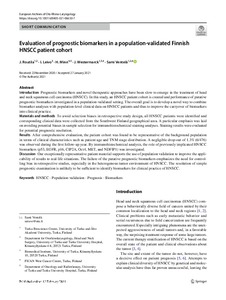Evaluation of prognostic biomarkers in a population-validated Finnish HNSCC patient cohort
Routila Johannes; Westermarck Jukka; Leivo Iivo; Minn Heikki; Ventelä Sami
https://urn.fi/URN:NBN:fi-fe2021093048648
Tiivistelmä
Introduction
Prognostic biomarkers and novel therapeutic approaches have been slow to emerge in the treatment of head and neck squamous cell carcinoma (HNSCC). In this study, an HNSCC patient cohort is created and performance of putative prognostic biomarkers investigated in a population-validated setting. The overall goal is to develop a novel way to combine biomarker analyses with population-level clinical data on HNSCC patients and thus to improve the carryover of biomarkers into clinical practice.
Materials and methods
To avoid selection biases in retrospective study design, all HNSCC patients were identified and corresponding clinical data were collected from the Southwest Finland geographical area. A particular emphasis was laid on avoiding potential biases in sample selection for immunohistochemical staining analyses. Staining results were evaluated for potential prognostic resolution.
Results
After comprehensive evaluation, the patient cohort was found to be representative of the background population in terms of clinical characteristics such as patient age and TNM stage distribution. A negligible drop-out of 1.3% (6/476) was observed during the first follow-up year. By immunohistochemical analysis, the role of previously implicated HNSCC biomarkers (p53, EGFR, p16, CIP2A, Oct4, MET, and NDFIP1) was investigated.
Discussion
Our exceptionally representative patient material supports the use of population validation to improve the applicability of results to real-life situations. The failure of the putative prognostic biomarkers emphasizes the need for controlling bias in retrospective studies, especially in the heterogenous tumor environment of HNSCC. The resolution of simple prognostic examination is unlikely to be sufficient to identify biomarkers for clinical practice of HNSCC.
Kokoelmat
- Rinnakkaistallenteet [19207]
